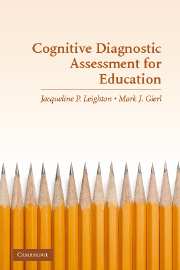Book contents
- Frontmatter
- Contents
- List of Contributors
- PART I THE BASIS OF COGNITIVE DIAGNOSTIC ASSESSMENT
- PART II PRINCIPLES OF TEST DESIGN AND ANALYSIS
- PART III PSYCHOMETRIC PROCEDURES AND APPLICATIONS
- 8 Cognitive Foundations of Structured Item Response Models
- 9 Using the Attribute Hierarchy Method to Make Diagnostic Inferences About Examinees' Cognitive Skills
- 10 The Fusion Model Skills Diagnosis System
- 11 Using Information from Multiple-Choice Distractors to Enhance Cognitive-Diagnostic Score Reporting
- 12 Directions for Future Research in Cognitive Diagnostic Assessment
- Author Index
- Subject Index
- References
10 - The Fusion Model Skills Diagnosis System
Published online by Cambridge University Press: 23 November 2009
- Frontmatter
- Contents
- List of Contributors
- PART I THE BASIS OF COGNITIVE DIAGNOSTIC ASSESSMENT
- PART II PRINCIPLES OF TEST DESIGN AND ANALYSIS
- PART III PSYCHOMETRIC PROCEDURES AND APPLICATIONS
- 8 Cognitive Foundations of Structured Item Response Models
- 9 Using the Attribute Hierarchy Method to Make Diagnostic Inferences About Examinees' Cognitive Skills
- 10 The Fusion Model Skills Diagnosis System
- 11 Using Information from Multiple-Choice Distractors to Enhance Cognitive-Diagnostic Score Reporting
- 12 Directions for Future Research in Cognitive Diagnostic Assessment
- Author Index
- Subject Index
- References
Summary
INTRODUCTION
There is a long history of calls for combining cognitive science and psychometrics (Cronbach, 1975; Snow & Lohman, 1989). The U.S. standards movement, begun more than 20 years ago (McKnight et al., 1987; National Council of Teachers of Mathematics, 1989), sought to articulate public standards for learning that would define and promote successful performance by all students; establish a common base for curriculum development and instructional practice; and provide a foundation for measuring progress for students, teachers and programs. The standards movement provided the first widespread call for assessment systems that directly support learning. For success, such systems must satisfy a number of conditions having to do with cognitive-science–based design, psychometrics, and implementation. This chapter focuses on the psychometric aspects of one particular system that builds on a carefully designed test and a user-selected set of relevant skills measured by that test to assess student mastery of each of the chosen skills. This type of test-based skills level assessment is called skills diagnosis. The system that the chapter describes in detail is called the Fusion Model system.
This chapter focuses on the statistical and psychometric aspects of the Fusion Model system, with skills diagnosis researchers and practitioners in mind who may be interested in working with this system. We view the statistical and psychometric aspects as situated within a comprehensive framework for diagnostic assessment test design and implementation.
- Type
- Chapter
- Information
- Cognitive Diagnostic Assessment for EducationTheory and Applications, pp. 275 - 318Publisher: Cambridge University PressPrint publication year: 2007
References
- 65
- Cited by



